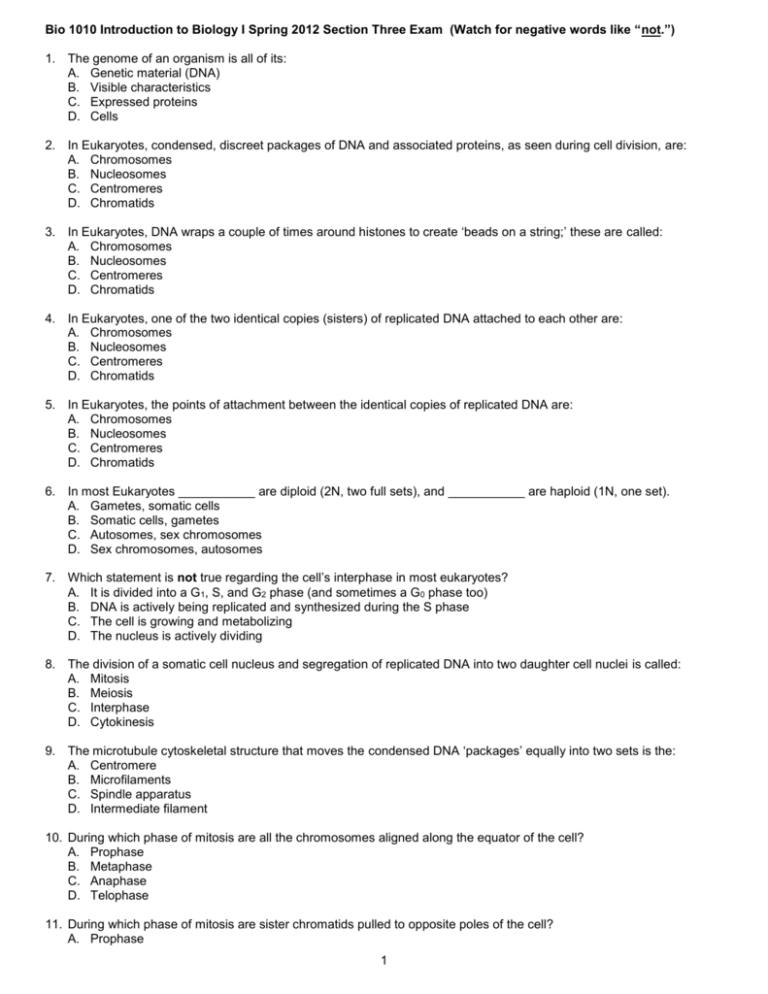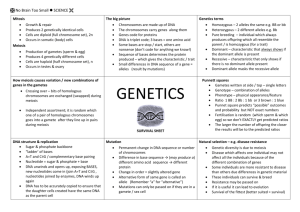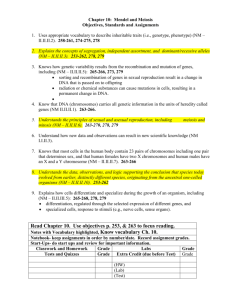Section 3 Exam
advertisement

Bio 1010 Introduction to Biology I Spring 2012 Section Three Exam (Watch for negative words like “not.”) 1. The genome of an organism is all of its: A. Genetic material (DNA) B. Visible characteristics C. Expressed proteins D. Cells 2. In Eukaryotes, condensed, discreet packages of DNA and associated proteins, as seen during cell division, are: A. Chromosomes B. Nucleosomes C. Centromeres D. Chromatids 3. In Eukaryotes, DNA wraps a couple of times around histones to create ‘beads on a string;’ these are called: A. Chromosomes B. Nucleosomes C. Centromeres D. Chromatids 4. In Eukaryotes, one of the two identical copies (sisters) of replicated DNA attached to each other are: A. Chromosomes B. Nucleosomes C. Centromeres D. Chromatids 5. In Eukaryotes, the points of attachment between the identical copies of replicated DNA are: A. Chromosomes B. Nucleosomes C. Centromeres D. Chromatids 6. In most Eukaryotes ___________ are diploid (2N, two full sets), and ___________ are haploid (1N, one set). A. Gametes, somatic cells B. Somatic cells, gametes C. Autosomes, sex chromosomes D. Sex chromosomes, autosomes 7. Which statement is not true regarding the cell’s interphase in most eukaryotes? A. It is divided into a G1, S, and G2 phase (and sometimes a G0 phase too) B. DNA is actively being replicated and synthesized during the S phase C. The cell is growing and metabolizing D. The nucleus is actively dividing 8. The division of a somatic cell nucleus and segregation of replicated DNA into two daughter cell nuclei is called: A. Mitosis B. Meiosis C. Interphase D. Cytokinesis 9. The microtubule cytoskeletal structure that moves the condensed DNA ‘packages’ equally into two sets is the: A. Centromere B. Microfilaments C. Spindle apparatus D. Intermediate filament 10. During which phase of mitosis are all the chromosomes aligned along the equator of the cell? A. Prophase B. Metaphase C. Anaphase D. Telophase 11. During which phase of mitosis are sister chromatids pulled to opposite poles of the cell? A. Prophase 1 B. Metaphase C. Anaphase D. Telophase 12. The actual physical separation of the two daughter cells in the cell cycle is called: A. Mitosis B. Meiosis C. Interphase D. Cytokinesis 13. Which of the following statements is not true regarding cell cycle regulation? A. Stem cells keep dividing pretty much the entire lifetime of a multicellular organism B. Cancer cells often express telomerase, which prevents shortening of telomeres C. Telomeres become longer and longer as most somatic cells divide D. Cell cycle checkpoints are important in regulating the cell cycle 14. Which of the following statements is not true regarding cancer? A. Most forms of cancer are highly contagious B. A malignant tumor actively grows and metastasizes other tissues C. Cancer cells lack contact inhibition and may make their own growth factors D. Mutations in oncogenes and tumor suppressor genes are often responsible 15. Programmed cell death, also called __________, has roles in embryology and in __________ damaged cells. A. Apoptosis, maintaining B. Apoptosis, eliminating C. Caspasis, maintaining D. Caspasis, eliminating 16. Sexual reproduction may have evolved as a mechanism: A. For insuring genetic variability in offspring in order to better cope with changing environmental threats B. That is more efficient, less risky, and that requires less overall energy than asexual reproduction C. To avoid potential mutations in DNA replication associated with asexual reproduction D. For insuring that offspring have identical genetics as their parents 17. Which of the following statements is not true regarding the discrete DNA ‘packages’ in most animal cells? A. The genetic information on a pair of homologous autosomes is exactly the same between the two B. Humans have 23 pairs of these ‘packages,’ for a total of 46, half maternal, half paternal C. Not all of these ‘packages’ are autosomes, one pair in many animals is XX or XY D. The autosomes are present as homologous pairs in most all somatic cells 18. Cells that undergo a single round of DNA replication, but two rounds of nuclear division, are undergoing: A. Cytokinesis B. Interphase C. Meiosis D. Mitosis 19. In meiosis, paired homologous DNA ‘packages’ align (double file) along the cell’s equator during: A. Metaphase I B. Metaphase II C. Anaphase I D. Anaphase II 20. In meiosis, separated sister chromatids move to the opposite poles of the cell during: A. Metaphase I B. Metaphase II C. Anaphase I D. Anaphase II 21. The final cytokinesis step of meiosis results in the production of: A. Two diploid daughter cells B. Two haploid daughter cells C. Four diploid daughter cells D. Four haploid daughter cells 2 22. Sexual reproduction and meiosis do not generate much significant genetic variability through: A. The random alignment of homologous pairs of DNA ‘packages’ during meiosis B. Crossing over (also called homologous recombination) during meiosis C. The fact that fertilization is a random phenomenon D. The replication of DNA prior to meiosis 23. Errors in meiosis can cause many problems. Which of the following cannot be caused by meiotic error? A. The insertion, deletion, or duplication of sections of DNA or entire genes B. The inversion or translocation of sections of DNA or entire genes C. Nondisjunction causing monosomy or trisomy D. Single point mutations 24. Every gene can have many different versions, with slightly different sequences; these are called: A. Chromosomes B. Chromatids C. Genomes D. Alleles 25. Which statement is not true regarding an organism’s genotype and phenotype? A. The genotype is an organism’s genetic makeup, that is, all of the DNA in all its genes B. The phenotype is the expression of an organism’s genotype C. We can directly observe an organism’s phenotype D. We can directly observe an organism’s genotype 26. An allele that will not express its trait, unless the other allele of the pair is identical to it, is called: A. Heterozygous B. Homozygous C. Recessive D. Dominant 27. If the two alleles for a particular gene are identical, the gene pair is: A. Heterozygous B. Homozygous C. Recessive D. Dominant 28. If the two alleles for a particular gene are different, the gene pair is: A. Heterozygous B. Homozygous C. Recessive D. Dominant 29. When Mendel crossed short pea plants with short pea plants, the offspring: A. Were sometimes all tall, but sometimes a mix of tall and short B. Were always a mix of tall and short C. Were always short D. Were always tall 30. When Mendel crossed tall pea plants with tall pea plants, the offspring: A. Were sometimes all tall, but sometimes a mix of tall and short B. Were always a mix of tall and short C. Were always short D. Were always tall 31. When Mendel crossed tall pea plants with short pea plants, the offspring: A. Were sometimes all tall, but sometimes a mix of tall and short B. Were always a mix of tall and short C. Were always short D. Were always tall 32. Mendel's monohybrid pea plant crosses resulted in F2 offspring with a phenotypic ratio of: A. 1:1 3 B. 2:1 C. 3:1 D. 9:3:3:1 33. A dihybrid cross mates two individuals that are both _____________ for ________ gene (or genes). A. Heterozygous, two B. Heterozygous, one C. Homozygous, two D. Homozygous, one 34. Mendel’s dihybrid pea plant crosses yielded phenotypic ratios in F 2 offspring of: A. 1:2:2:1:4:1:2:2:1 B. 9:3:3:1 C. 4:2:1 D. 3:1 35. If a heterozygote phenotype is intermediate between that of the two corresponding homozygote phenotypes: A. It is an example of epistasis and/or a polygenic trait B. It is an example of a simple Mendelian trait C. It is an example of incomplete dominance D. It is an example of codominance 36. If both genotypes for a gene are fully expressed in a heterozygote phenotype (e.g. AB blood type): A. It is an example of epistasis and/or a polygenic trait B. It is an example of a simple Mendelian trait C. It is an example of incomplete dominance D. It is an example of codominance 37. However, most phenotypic traits actually depend on the complex interactions of more than one gene: A. This is an example of epistasis and/or polygenic traits B. This is an example of simple Mendelian traits C. This is an example of incomplete dominance D. This is an example of codominance 38. As seen in the video on sex determination, androgen insensitivity syndrome is a good example of: A. Epistasis and/or a polygenic trait B. A simple Mendelian trait C. Incomplete dominance D. Codominance 39. A diagram or micro-photograph of all the discreet ‘packages’ of DNA in animals arranged by size, banding pattern, centromere position, and arm length, is called: A. Karyotype B. Pleiotropy C. Colchicine D. Recombinant 40. Linked genes are genes that: A. Occur close together on the same chromosome, so they are inherited separately B. Occur close together on the same chromosome, so they are inherited as a unit C. Occur on different chromosomes, so they are inherited separately D. Occur on different chromosomes, so they are inherited as a unit 41. If any of the traits that Mendel worked with had been due to linked genes, then his dihybrid crosses: A. Would have exhibited a phenotypic ratio of 9:3:3:1 B. Would have exhibited a genotypic ratio of 9:3:3:1 C. Would have exhibited a phenotypic ratio of 3:1 D. Would have exhibited a genotypic ratio of 3:1 42. Crossing over (homologous recombination) that separates genes can occur during meiosis, if the genes are: A. Very close together on the same chromosome B. Quite far apart on the same chromosome C. Very close together on two different chromosomes D. Quite far apart on two different chromosomes 4 43. Chromosome maps are not based on which of the following criteria? A. A statistical correlation between crossover frequency and a distance (centimorgans) between genes B. Known genetic marker sequences and particular phenotypes (QTL mapping) C. Exact DNA sequences with known base pairs from genome sequencing D. Distances measured with a ruler 44. Which of the following statements would result in an autosomal recessive disorder being displayed? A. A person needs to get the disease causing allele only from the one parent who has the disease B. A person needs to get the disease causing allele only from the mother, not the father C. A person needs to get the disease causing allele only from the father, not the mother D. A person needs to get the disease causing allele from both parents 45. The ‘normal’ chromosomal designation for a human female is: A. XXX B. XXY C. XX D. XY 46. The ‘normal’ chromosomal designation for a human male is: A. XXX B. XXY C. XX D. XY 47. The SRY gene located on the _____________ begins the _____________ pathway in most mammals. A. Y chromosome, gender determination B. X chromosome, gender determination C. Y chromosome, sex determination D. X chromosome, sex determination 48. Human males are ____________ for X chromosome sex-linked traits, because they only have one copy. A. Homologous B. Homozygous C. Hemizygous D. Heterozygous 49. Which of the following statements is true regarding sex-linked genes in humans? A. For a female to express a X-linked, dominant trait, she needs two copies of the allele B. For a female to express a X-linked recessive trait, she only needs one copy of the allele C. For a male to express a X-linked dominant trait, he needs two copies of the allele D. For a male to express a X-linked recessive trait, he only needs one copy of the allele 50. The mechanism that evolved to compensate for ‘double-dose’ XX females versus XY males is called: A. Epistasis B. Pleiotropy C. X inactivation D. Codominance 5







